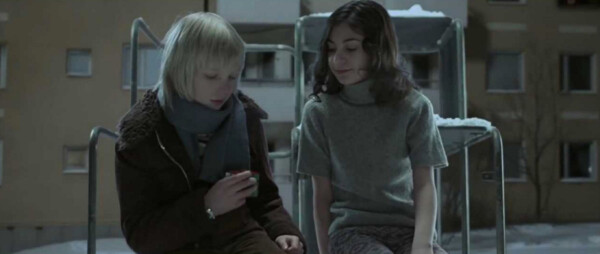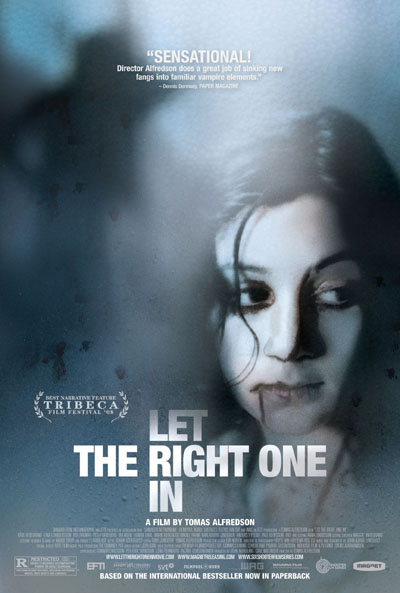Del and Mladen review ‘Let the Right One In’

Image courtesy of EFTI, Sveriges Television and Filmpool Nord.
—
“Let the Right One In” Starring Kare Hedebrant, Lena Leandersson, Per Ragnar, Karen Bergquist. Directed by Tomas Alfredson. 115 minutes. Rated R.
Del’s take
You’re a 12-year-old boy and the bullies at school are eating your lunch. Wouldn’t it be nice if you could invoke the powers of your vampire girlfriend for a bloody session of attitude adjustment?
That’s the premise of “Let the Right One In,” a Swedish vampire flick that eerily and effectively reminds us that love comes along when it’s least expected, and from the unlikeliest of angles.
Oskar (Kare Hedebrant) is a pale, frail wisp of a boy who receives the unwanted attentions of a trio of bad boys at his school in the Stockholm suburb of Blackeberg. He fantasizes about revenge, sticking a knife into a tree and clipping newspaper articles about murders.
His home life isn’t much better. His parents are divorced. His alcoholic father lives in the country with a male friend while his mother works full-time and comes through the front door frazzled and worried. He spends much of his time at his apartment complex’s playground, dreaming of the escape he will never make happen.
He meets Eli (Lena Leandersson), the strange girl who has moved into the unit next door. She only comes out at night and seems impervious to the Swedish cold. Despite her pronouncement that she doesn’t want to be friends the two are drawn to each other, perhaps by their mutual strangeness.
Soon, bizarre murders haunt the streets of Blackeberg and Oskar, with Eli’s encouragement, stands up to his tormentors – the results are tragic. Still, “Let the Right One In” provides an option for hope.
But its most powerful virtue is the subtle elegance of its storytelling. “Let the Right One In” is flecked with moments of brutality, as any good 21st century vampire story must be. But it is also a serene journey through quiet, nighttime snowfalls, the unremitting gray of winter and the inevitable slide into dissolution that in this case is tempered by a weird redemption.
American audiences will not like the subtitles but never fear, in the tradition of “The Ring” and “The Grudge,” an Americanized version is due out this year.
“Let the Right One In” is not a movie for children or adults with timid constitutions. For everyone else it is a strange poem that will leave an uneasy impression that like water – or blood – love finds a way into the hardest of hearts.

Mladen’s take
It’s clear by watching “Let the Right One In” that a vampire-friend would be useful if you’re the victim of bullies in middle school. Any middle school. Even a middle school in Sweden, where this very good, intermittently troubling film was made.
Before proceeding, let me stress that the penultimate scene in “Let the Right One In” offers one the finest pieces of cinematic slaughter ever created. Like much of the rest of the movie, its director, Tomas Alfredson, filmed the segment sparingly but punctuated it with bits of vivid dismemberment. The soundless incident was mesmerizing, not ghastly, though the victims were a couple of pre-teenagers and one adolescent.
“Let the Right One In” defies Hollywood-homogenized vampire film plots. It isn’t a sappy romance such as “Twilight” or a bloodletting similar to “30 Days of Night.”
It’s a movie about friendship, exploring the nature of honesty, loyalty, and trust. The protagonists are 12 years old but their struggles resonate with what we face as adults.
In one scene the dark-haired vampire cutie Eli accepts Oskar’s unvoiced gesture to enter his home, though he knows she must be invited verbally. Eli willingly placed her life in his hands by crossing the threshold and endured near-disintegration before he blurted “Come in” to end the horror.
Friendships have a darker side, too.
There’s the matter of making choices that close doors leading to other forms of happiness. There’s the urge to reciprocate. And, we inevitably become a little like the people considered friends.
Eli, shortly after the threshold incident, pounces on Oskar. She urges him too become more like her, something that, in fact, had been happening since the two met. Pay attention. At this moment and a couple of others, Eli’s young, creaseless face transforms, betraying the true age of her worn soul.
The movie ends with the impression that Eli had become more mankind-like and Oskar, more vampire-like, but both were human. Each of the two beings, it seems, had let the right one in.
Mladen Rudman is a former journalist and technical editor. Del Stone Jr. is a former journalist and author.